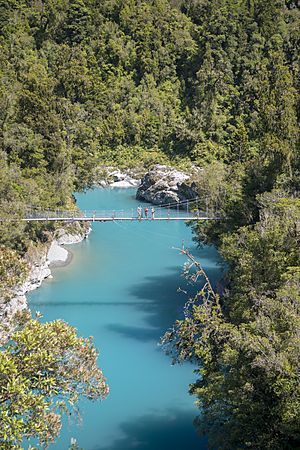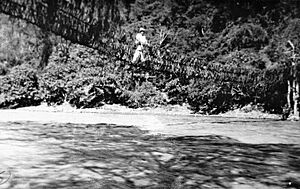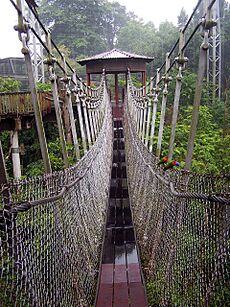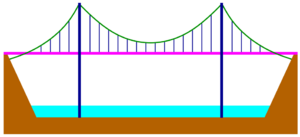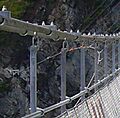Simple suspension bridge facts for kids
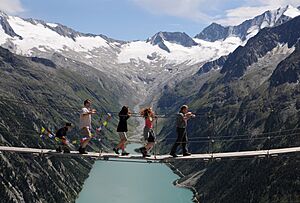
A simple suspension footbridge in the Zillertal Alps
|
|
| Descendant |
|
|---|---|
| Carries | Pedestrians, livestock |
| Span range | short to medium |
| Material | Rope (fiber), chain, steel wire rope; appropriate decking material |
| Movable | No |
| Design effort | low |
| Falsework required | No |
A simple suspension bridge is a basic type of bridge. It's also called a rope bridge or hanging bridge. These bridges have a flat surface, called a deck, that rests on two strong cables. These cables are tied down at each end.
Unlike other bridges, they don't have tall towers or piers in the middle. The cables hang in a gentle curve, like a U-shape. This curve can move a bit when people or animals walk on the bridge.
Because the deck moves a lot, these bridges are not good for cars or trucks. They are mostly used by people walking. They often have strong handrail cables for safety. These handrails run next to the main cables. Sometimes, the handrail cables are even the main support. Simple suspension bridges are great for rural areas, especially over rivers in deep valleys.
Contents
How They Are Different
Sometimes, people use "simple suspension bridge" to mean a bridge where the deck isn't stiff. But there's a key difference. In a true simple suspension bridge, the main cables hang freely. They form a special curve called a catenary.
In other types of suspension bridges, like those with a suspended deck, the main cables are tied to the deck at many points. This makes the cables form a different curve, called a parabola.
Another type is the stressed ribbon bridge. It also has cables that curve. But its deck is very stiff, usually with concrete slabs over the cables. This makes it much stronger and more stable. It can even carry vehicles.
History of Simple Suspension Bridges
Simple suspension bridges are the oldest kind of suspension bridge. They were invented in at least two different places. One was in the Himalaya region, and the other was in South America.
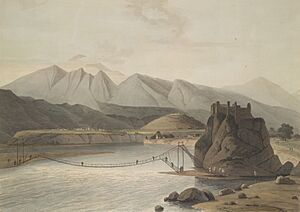
The first records of these bridges come from ancient China. Chinese travelers wrote about them in the Himalaya mountains. These early bridges were made of three or more ropes from vines. People walked directly on the ropes. Later, they added wooden planks to walk on.
In South America, the Inca rope bridges were built before the Spanish arrived in the 1500s. The oldest known suspension bridge ruins are from the 600s in Central America.
Simple suspension bridges made with iron chains were also built in Tibet and China. One bridge over the Yangtze River dates back to the 600s. A famous monk named Thang Tong Gyalpo built many in the 1400s. The Luding Bridge, built in 1703, uses 11 iron chains and spans 100 meters.
Modern wire cable suspension bridges started with a temporary bridge in France in 1822. But the invention of the suspended deck bridge by James Finley in the 1800s made simple suspension bridges less common for large projects.
Materials Used
These bridges are often called "rope bridges" because they were historically made from rope. Some Inca rope bridges in South America are still made from local materials, mostly rope. These bridges need to be rebuilt often because the materials wear out. Families in the community work together to make new rope parts.
Today, simple suspension bridges for people and animals are still built. They use modern materials like wire rope and sometimes steel or aluminium for the deck. This is instead of wood.
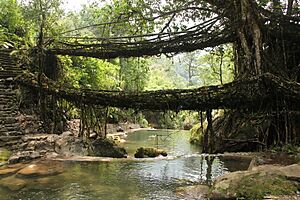
In some places, people use living plants to make bridges! In India, the Khasi and Jaintia tribes grow living root bridges. They train the roots of Ficus elastica (banyan trees) to grow across rivers. Some of these bridges are over 50 meters long. They get stronger as the roots grow and can be hundreds of years old.
In Japan's Iya Valley, bridges are made from wisteria vines. People plant the vines on opposite sides of a river. When they grow long enough, they weave them together. Then they add planks to create a bridge.
How They Are Designed
The simplest simple suspension bridges are just a single rope to walk on. These are like tightropes and need a lot of skill to use. More often, there's a footrope and one or two handrail ropes. These are connected by smaller ropes. This style is used by mountain climbers. In New Zealand, they are called 'three wire bridges'.
A slightly stronger version has two ropes supporting a deck, plus two handrail ropes. Handrails are important because these bridges can swing a lot from side to side.
Sometimes, the main support cables are actually the handrails. The deck then hangs below them. This can make the deck swing more, but the handrails feel more stable.
Simple suspension bridges have some downsides. The deck can only be in a certain place. They need very strong anchor points on the ground. Also, when people walk on them, the deck can temporarily change shape. To fix these issues, engineers developed other types of suspension bridges with stiffer decks. A stressed ribbon bridge is one example. It's similar but has a stiff deck that can handle vehicles.
Some light bridges use very tight cables. These can feel almost flat, like a suspended deck bridge. Engineers can also add extra cables that don't carry the main weight. These lighter cables help make the bridge more stable in the wind. For example, a bridge over the Drac river in France has stabilizing cables below and to the side of its deck.
To stop the bridge from twisting when people cross, vertical cables can be added. These drop from the middle of the bridge and are anchored to the ground below.
How They Are Used
The very lightest simple suspension bridges, without a deck, are only for people to walk on. Stronger bridges with a deck can also be used by animals like pack horses, people riding horses, and cyclists.
Walking on a lighter simple suspension bridge can be tricky. You might need a special gliding step. If you walk normally, the bridge can bounce up and down or sway side to side. But a stabilized bridge can be quite steady.
Simple suspension bridges are popular for outdoor fun. You can find them on tree-top trails or crossing streams. Some are even designed to sway a bit. This makes crossing them a more exciting adventure!
In French, a basic simple suspension bridge has different names. A pont himalayen (Himalayan bridge) has a footrope and handrails but usually no deck. A pont de singe (monkey bridge) has a footrope with an overhead rope. A tyrolienne (Tyrolean) is a zip-line. You can hang below a zip-line or, if you have amazing balance, even walk on it. A more developed pont himalayen with a deck is called a passerelle himalayenne (Himalayan footbridge). Some of these, like two bridges at Lac de Monteynard-Avignonet in the French Alps, are very long.
Famous Simple Suspension Bridges
Here are some well-known simple suspension bridges:
| Name | Length | Year built |
|---|---|---|
| Capilano Suspension Bridge | 140 metres (460 ft) | 1889 |
| Arroyo Cangrejillo Pipeline Bridge | 337 metres (1,106 ft) | 1998 |
| Lac de Monteynard-Avignonet Drac bridge | 220 metres (720 ft) | 2007 |
| Carrick-a-Rede Rope Bridge | 20 metres (66 ft) | rebuilt 2008 |
| Ponte tibetano Cesana-Claviere | 478 metres (1,568 ft) | 2006 |
| Ponte nel Cielo | 234 metres (768 ft) | 2018 |
| Charles Kuonen Suspension Bridge | 494 metres (1,621 ft) | 2017 |
| Gandaki Golden Footbridge | 567 metres (1,860 ft) | 2020 |
| Arouca 516 | 516 metres (1,693 ft) | 2021 |
| Ponte tibetano di Castelsaraceno | 586 metres (1,923 ft) | 2021 |
| Sky Bridge 721 | 721 metres (2,365 ft) | 2022 |
| Ponte tibetano di Sellano | 517.5 metres (1,698 ft) | 2024 |
Images for kids
-
A simple suspension bridge in Bohol, Philippines.
-
The Capilano Suspension Bridge, supported by its handrail cables.
See also
- Category:Simple suspension bridges
- Inca Bridge
- Stressed ribbon bridge (a bridge with a stiff deck)
- Zip-line
- Suspension bridge types


